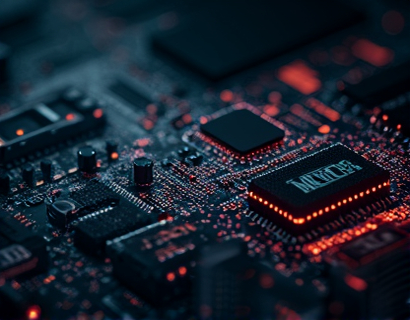DeFi Trading Optimized: Harnessing the Power of Advanced Smart Contract AMMs for Enhanced Automation and Liquidity
In the rapidly evolving world of decentralized finance, or DeFi, traders and enthusiasts are constantly seeking ways to optimize their trading experiences. One of the most significant advancements in this space is the integration of advanced smart contract Automated Market Makers (AMMs) which are transforming liquidity management and automating trading strategies. This article delves into how these technologies are revolutionizing the DeFi ecosystem, providing a seamless and efficient market interaction for crypto traders.
Understanding AMMs in DeFi
Automated Market Makers, or AMMs, are decentralized protocols that facilitate trading without traditional order books. Instead, they use mathematical formulas and liquidity pools to determine prices and execute trades. The core idea behind AMMs is to provide a continuous market for trading tokens, ensuring liquidity and price discovery in a trustless environment. Unlike traditional market makers, AMMs do not rely on human intervention to set prices or manage liquidity, making them highly efficient and accessible.
Key Components of Smart Contract AMMs
Smart contract AMMs are built on blockchain technology, leveraging the transparency and security of decentralized networks. The primary components of these AMMs include liquidity pools, price calculation algorithms, and trading mechanisms.
Liquidity pools are the backbone of AMMs, where users deposit tokens to create a pool from which traders can borrow and lend. These pools are managed by smart contracts, ensuring that the liquidity is available 24/7 without the need for intermediaries. The more liquidity provided to a pool, the lower the trading fees and the better the execution prices for traders.
The price calculation algorithm is another critical component. Most AMMs use a constant product formula, such as x * y = k, where x and y represent the amounts of two tokens in a pool, and k is a constant. This formula ensures that the price of a token in the pool is inversely proportional to its quantity. When a trade occurs, the amounts of the tokens in the pool adjust according to this formula, maintaining the balance and ensuring fair pricing.
Trading mechanisms in AMMs are designed to be simple and efficient. Users interact with the smart contract to deposit or withdraw tokens from a liquidity pool, and to execute trades. The smart contract automatically calculates the trade ratio based on the current pool balances and executes the trade, updating the pool's token amounts accordingly. This process is fully automated and occurs on the blockchain, eliminating the need for trust in a central authority.
Enhanced Automation through Smart Contracts
One of the most significant advantages of using smart contract AMMs is the level of automation they provide. Traders can set up automated trading strategies, known as algorithmic trading or arb trading, directly within the smart contract. These strategies can execute complex trades based on predefined conditions, such as price thresholds or market movements, without the need for manual intervention.
For instance, a trader can create a smart contract that automatically buys a token when its price drops below a certain level and sells it when the price rises above another level. This not only saves time but also reduces the risk of human error and emotional decision-making. The smart contract ensures that trades are executed precisely according to the programmed rules, providing a high degree of consistency and reliability.
Improved Liquidity Management
Liquidity management is a critical aspect of DeFi trading, and smart contract AMMs offer several advantages in this area. By allowing users to deposit and withdraw tokens from liquidity pools, AMMs ensure that liquidity is always available, even during periods of high market volatility. This is particularly important for smaller tokens that may struggle to attract sufficient liquidity on traditional exchanges.
Moreover, the fee structure in AMMs is typically more favorable for liquidity providers. Instead of taking a spread on each trade, AMMs charge a small percentage of the trade value as a fee, which is distributed to the liquidity providers. This incentivizes more users to contribute liquidity, further enhancing the depth and liquidity of the market.
Another benefit is the ability to manage liquidity across multiple pools simultaneously. Smart contracts can be programmed to allocate liquidity dynamically based on market conditions, optimizing returns and minimizing risks. This level of flexibility is not possible with traditional trading platforms, where liquidity management is often manual and less responsive to market changes.
Use Cases and Applications
The applications of smart contract AMMs extend beyond simple token trading. They are being used in a variety of DeFi applications, including lending, borrowing, and yield farming. For example, liquidity providers can earn passive income by depositing tokens into lending protocols, which then use the liquidity to facilitate loans to other users. The fees generated from these loans are shared with the liquidity providers, creating a win-win situation.
Yield farming is another popular use case, where users deploy smart contracts to automatically rebalance their token holdings across different DeFi protocols to maximize returns. AMMs play a crucial role in this process by providing the necessary liquidity and price discovery mechanisms.
Additionally, AMMs are being integrated into decentralized exchanges (DEXs) to offer a more user-friendly and efficient trading experience. These DEXs leverage the power of AMMs to provide continuous markets for a wide range of tokens, making it easier for users to trade without the need for order books or central custodians.
Challenges and Considerations
While smart contract AMMs offer numerous benefits, there are also challenges and considerations that traders and developers must be aware of. One of the primary concerns is smart contract security. As with any blockchain-based application, the risk of vulnerabilities and exploits exists. It is crucial for developers to conduct thorough audits and follow best practices to ensure the security of their smart contracts.
Another challenge is the complexity of using AMMs, which can be a barrier for less tech-savvy users. User interfaces and educational resources are essential to make these platforms accessible to a broader audience. Additionally, the fee structure, while generally favorable, can still impact trading costs, especially for high-frequency traders.
Market volatility remains a factor to consider, as AMMs are not immune to the fluctuations in token prices. However, the automated nature of AMMs can help mitigate some of these risks by providing liquidity and price stability in times of market stress.
Future Developments
The future of smart contract AMMs in DeFi is promising, with several developments on the horizon. One area of focus is the integration of advanced analytics and machine learning algorithms to enhance trading strategies and liquidity management. These technologies can provide deeper insights into market trends and optimize trading decisions in real-time.
Interoperability between different blockchain platforms is another key development. As more DeFi protocols become compatible across various chains, users will have greater flexibility in managing their liquidity and executing trades across multiple ecosystems. This will further enhance the utility and appeal of smart contract AMMs.
Regulatory clarity is also expected to play a significant role in the growth of AMMs. As governments and regulatory bodies begin to understand and address the unique aspects of DeFi, we can anticipate more robust frameworks that support innovation while protecting users. This will likely lead to increased adoption and investment in AMM-based DeFi projects.
Conclusion
Smart contract AMMs are revolutionizing the DeFi landscape by providing a powerful tool for enhanced automation and liquidity management. By leveraging the transparency and security of blockchain technology, these platforms offer a seamless and efficient trading experience for crypto enthusiasts and professionals alike. As the ecosystem continues to evolve, the potential for innovation and growth in DeFi trading is immense, making smart contract AMMs an essential component of the future financial landscape.











































